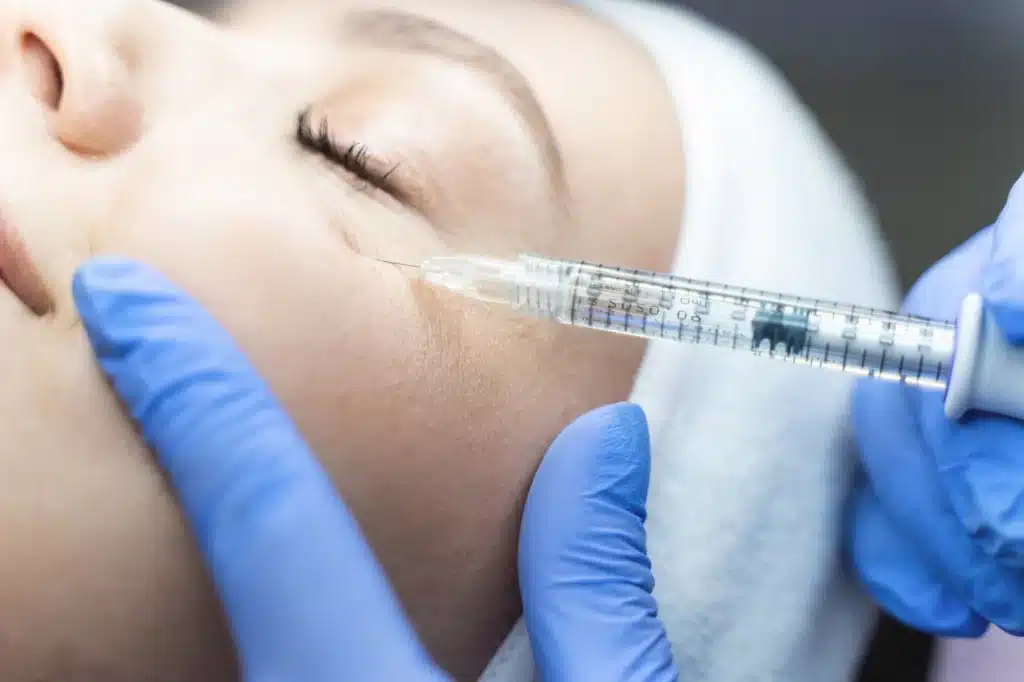Although these words sound similar and are often used interchangeably, some key differences between an esthetician and an aesthetician. While both professions involve skincare, and their specialties overlap very much, they differ in terms of their level of training, the services they provide, and the settings in which they work.
What Is an Aesthetician?
Aestheticians, also called medical or clinical aestheticians, are healthcare professionals who specialize in cosmetic medical procedures. They are typically licensed medical professionals, such as nurses or doctors, who have undergone additional training in cosmetic procedures, such as:
- injectables,
- laser treatments,
- chemical peels.
Aestheticians work in medical settings, such as clinics, hospitals, dental offices, or medical spas. Their services are often more invasive than those provided by estheticians.
They treat patients with various health issues, skin damage from chemotherapy, burns, surgeries, etc., and usually work alongside a physician, plastic surgeon, or dermatologist.
What Is an Esthetician?
An esthetician is a licensed skincare professional specializing in treating the skin through various techniques, including facials, waxing, and exfoliation.
Estheticians are trained in skincare science and use their knowledge to evaluate and treat multiple skin concerns like acne, aging, hyperpigmentation, or hair removal. They may also advise clients on skincare products and routines.
Estheticians can work in various settings, including spas, beauty salons, cosmetology clinics, and resorts. They may also specialize in specific areas of skincare, for instance, treating acne, doing facials or body treatments, waxing, massages, makeup, etc.
To become an esthetician, one must complete a formal training program and pass a state licensing exam. The training program typically covers anatomy and physiology, skin analysis, skincare products, and various treatment techniques.
What Is the Difference Between Aestheticians and Estheticians?
Although aestheticians and estheticians help their clients achieve better skin, they have different levels of education and training programs.
Another difference between the two professions is the type of services they provide. Estheticians generally offer non-invasive treatments focused on improving the appearance of the skin. Their services include facials, peels, and hair removal.
On the other hand, aestheticians provide more invasive procedures, such as injectables, laser treatments, and chemical peels, that require medical knowledge and training.
Finally, the settings in which the two professions work are also different. Estheticians typically work in spas, salons, or beauty clinics. In contrast, aestheticians work in medical environments such as hospitals, private physician practices, dental clinics, or medical spas. In addition, aestheticians work under the supervision of a licensed physician, and their services may be covered by medical insurance.
Job Responsibilities For Aestheticians vs. Estheticians
Aesthetician job responsibilities are vast, including various procedures and treatments focused on improving the appearance of the skin. One of their primary tasks is providing skin tightening therapies that encourage collagen production under loose skin, skin rejuvenation and resurfacing.
Additionally, aesthetician procedures may include microlaser peels, laser hair or tattoo removal, scar or blemish reduction, varicose vein treatment using sclerotherapy, and applying permanent or semi-permanent makeup such as eyebrow fillings, eyeliner, eyelash extensions, lip color, and microblading.
They also consult with patients, answer their questions, recommend treatments, and keep patient records up to date.
On the other hand, an esthetician’s job responsibilities include skin analysis, cleansing, and exfoliation, applying masks and scrubs to refine pores, hydrating the skin, creating an even complexion, and making skin look younger or firmer.
They also perform massages, facials, aromatherapy, hair removals such as waxing, tweezing, threading, and eyebrow shaping, makeup application, and treating acne, sun damage, wrinkles, and oily or dry skin.
Additionally, estheticians prepare patients for Botox injections or dermal fillers and provide them with post-injection care. They also perform body sculpting to reduce cellulite and give skin product recommendations while showing clients how to use them properly.
Overall, both aesthetician and esthetician jobs involve a range of skincare procedures and treatments, but the focus and extent of their responsibilities vary.
Training Requirements
Both estheticians and medical aestheticians undergo formal education and training in cosmetology or esthetics. They can obtain various certificates, diplomas, or degrees. Regardless of the type of education program, practical training must be completed before becoming eligible for licensure.
Skincare specialist and esthetician programs provide hands-on training and coursework in a range of areas, including Ellanse and other dermal filler training, Botox injection training, laser hair removal, photo facial skin rejuvenation, laser wrinkle reduction, tattoo removal, body contouring, skin tightening, sclerotherapy, make-up application, as well as business and communication skills.
While the esthetician and aesthetician programs have similarities, their focus is the significant difference. Esthetician programs are more generalized, whereas medical aestheticians have a clinical and specialized focus.
Estheticians typically complete a program ranging from 300 to 1500 hours, depending on the state where they practice. The program covers basic skincare techniques and may include anatomy, physiology, and chemistry courses.
On the other hand, aestheticians must complete a medical degree or nursing program before undergoing additional training in cosmetic procedures. The education program for aesthetic medical procedures can vary. However, it generally involves a combination of classroom instruction and hands-on training under the supervision of a licensed physician.
The U.S. Bureau of Labor Statistics (BLS) states that all states require personal appearance workers, including skincare specialists, to be licensed. Licensing requirements differ from state to state but typically require formal training and a high school diploma. Some states also require a minimum number of completed training hours and a minimum age requirement for licensure.
What Are the Average Salaries of Both Careers?
In terms of salary, the average pay for Aestheticians and Estheticians can vary depending on several factors, such as location, experience, education, and type of employer. According to the Bureau of Labor Statistics (BLS), the median annual wage for skincare specialists, including Aestheticians and Estheticians, was $45,760 as of May 2021. However, the BLS data does not distinguish between the aesthetician and the esthetician.
In some areas, Aestheticians may earn higher salaries than Estheticians because they may have more advanced training, meaning they can perform additional services, such as laser treatments or injectables. Aestheticians may also work in medical spas or plastic surgery clinics, offering higher salaries than traditional beauty salons.
On the other hand, Estheticians may earn lower salaries than Aestheticians because they may be limited in the services they can perform and the types of establishments where they can work. Estheticians work primarily in beauty salons, day spas, or skincare clinics.
It’s important to note that these are generalizations, and salaries can vary widely depending on the specific location, employer, and individual qualifications of the Aesthetician or Esthetician.
Additionally, the demand for skin care services is expected to grow, which could lead to increased opportunities and potentially higher salaries for licensed skincare professionals in the coming years.
Conclusion
To sum it up, while aestheticians and estheticians work in the skin care field, they differ in their level of training, the type of services they provide, and the settings in which they work.
The main difference between esthetics and aesthetics is that estheticians provide essential skincare treatments and work in spas and salons, while aestheticians are licensed medical professionals who offer more invasive procedures and work in medical settings.
But both professions play an important role in helping clients achieve healthy, beautiful skin.
FAQ
Is aesthetics the same as an esthetician?
Aestheticians are licensed skin care professionals with advanced training in medical procedures beyond traditional cosmetic treatments. These medical procedures can include chemical peels, microdermabrasion, and laser treatments to address various skin conditions, such as acne, rosacea, and fine lines.
Estheticians are professionals who focus on cosmetic, cleaning, and exfoliating procedures.
What type of aesthetician makes the most money?
The highest salary belongs to Injection Specialists. According to 2023 statistics in the USA, they earn approximately $35,000-$88,000 annually (depending on the location, skills, etc.).
What is the difference between an esthetician and a medical aesthetician?
Estheticians typically provide cosmetic treatments and skincare services to clients with mild skin conditions, such as dryness, age spots, or minor acne. They focus on improving the appearance and texture of the skin using non-invasive procedures and skincare products.
These professionals may also offer advice and recommendations for at-home skincare routines to help clients maintain healthy and glowing skin.
Licensed medical aestheticians undergo specialized training beyond standard esthetician certification. As a result, they possess the expertise to improve the appearance and health of the skin and address specific skin issues associated with medical conditions or treatments.
In addition, they provide valuable advice and treatment options to individuals experiencing problems with sensitive skin.
References
Best Accredited Colleges / What’s the Difference Between an Aesthetician and Esthetician?. (2021, Oct 20 of publication). Retrieved from https://bestaccreditedcolleges.org/articles/whats-the-difference-between-an-aesthetician-and-esthetician.html
Ashley Jones. Everything you need to know about becoming an esthetician. Ladders. April 30, 2021. Retrieved from https://www.theladders.com/career-advice/everything-you-need-to-know-about-becoming-an-esthetician
National Coalition of Estheticians Association: “Frequently Asked Questions,” “NCEA Certified – National Credential Overview.” https://nceacertified.org/ncea-certification-overview-2/
Bureau of Labor Statistics, U.S. Department of Labor, Occupational Outlook Handbook, Skincare Specialists, at https://www.bls.gov/ooh/personal-care-and-service/skincare-specialists.html
Duke Health: “Skin Care Treatments.” https://www.dukehealth.org/treatments/dermatology/skin-care
12 of the Highest Paying Esthetician Jobs in 2023. Zip Recruiter. https://www.ziprecruiter.com/g/Highest-Paying-Esthetician-Jobs





